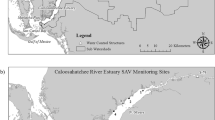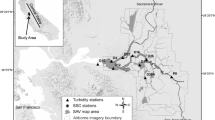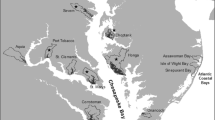Abstract
Aquatic vegetation is a key component of large floodplain river ecosystems. In the Upper Mississippi River System (UMRS), there is a long-standing interest in restoring aquatic vegetation in areas where it has declined or disappeared. To better understand what constrains vegetation distribution in large river ecosystems and inform ongoing efforts to restore submersed aquatic vegetation (SAV), we delineated areas in ~1200 river km of the UMRS where the combined effects of water clarity, water level fluctuation, and bathymetry appeared suitable for establishment and persistence of SAV based on a 22-year dataset for total suspended solids (TSS), water surface elevation, and aquatic vegetation distribution. We found a large increase in suitable area downstream from a large natural riverine lake near the northern end of the UMRS (river km 1230) that functions as a sink for suspended material. Downstream from river km 895, there was much less suitable area due to decreased water clarity from tributary input of suspended material, changes in river geomorphology, and increased water level fluctuation. A hypothetical scenario of 75% reduction in TSS resulted in only minor increases in suitable area in the southern portion of the UMRS, indicating limitations by water level fluctuation and/or bathymetry (i.e., limited shallow area). These results improve our understanding of the structure and function of large river systems by illustrating how water clarity, fluctuations in water level, and river geomorphology interact to create complex spatial patterns in habitat suitability for aquatic species and may help to identify locations most and least likely to benefit from management and restoration efforts.






Similar content being viewed by others
References
Alahuhta J, Lindholm M, Baastrup-Spohr L, Garcia-Giron J, Toivanen M, Heino J, Murphy K (2021) Macroecology of macrophytes in the freshwater realm: patterns, mechanisms, and implications. Aquatic Botany 168:103325
Barko JW, Gunnison D, Carpenter SR (1991) Sediment interactions with submersed macrophyte growth and community dynamics. Aquatic Botany 41:41–65
Bouska KL, Houser JN, De Jager NR, Hendrickson J (2018) Developing a shared understanding of the Upper Mississippi River: the foundation of an ecological resilience assessment. Ecology and Society 23:23. https://doi.org/10.5751/ES-10014-230206
Bouska KL, Houser JN, De Jager NR, Drake DC, Collins SF, Gibson-Reinemer DK, Thomsen MA (2020) Conceptualizing alternate regimes in a large floodplain-river ecosystem: water clarity, invasive fish, and floodplain vegetation. Environmental Management 264:110516. https://doi.org/10.1016/j.jenvman.2020.110516
Buijse AD, Coops H, Staras M, Jans LH, Van Geest GJ, Grifts RE, Ibelings BW, Oosterberg W, Roozen FCJM (2002) Restoration strategies for river floodplains along large lowland river in Europe. Freshwater Biology 47:889–907
Burdis RM, DeLain SA, Lund EM, Moore MJC, Popp WA (2020) Decadal trends and ecological shifts in backwater lakes of a large floodplain river: upper Mississippi River. Aquatic Sciences 82. https://doi.org/10.1007/s00027-020-0703-7
Caraco N, Cole J, Findlay S, Wigand C (2006) Vascular plants as engineers of oxygen in aquatic systems. BioScience 56:219–225
Carhart AM, De Jager NR (2018) Spatial and temporal changes in species composition of submersed aquatic vegetation reveal effects of river restoration. Restoration Ecology 27:672–682
Ciecierska H, Kolada A (2014) ESMI: a macrophyte index for assessing the ecological status of lakes. Environmental Monitoring and Assessment 186:5501–5517
Coops H, Hanganu J, Tudor M, Oosterberg W (1999) Classification of Danube Delta lakes based on aquatic vegetation and turbidity. Hydrobiologia 415:187–191
Coops H, Van Geest GJ (2003) Extreme water-level fluctuations determine aquatic vegetation in modified large river floodplains. Large Rivers 15:261–274
Dabney SM, Delgado JA, Reeves DW (2001) Using winter cover crops to improve soil and water quality. Communications in Soil Science and Plant Analysis 32:1221–1250
De Jager N, Yin Y (2010) Temporal changes in spatial patterns of submersed macrophytes in two impounded reach the upper Mississippi River, USA, 1998–2009. River Systems 19:129–141
De Jager N, Rohweder J (2017) Changes in aquatic vegetation and floodplain land cover in the upper Mississippi and Illinois rivers (1989–2000–2010). Environmental Monitoring and Assessment 189:77. https://doi.org/10.1007/s10661-017-5774-0
De Jager NR, Rogala JT, Rohweder JJ, Van Appledorn M, Bouska KL, Houser JN, Jankowski KJ (2018) Indicators of ecosystem structure and function for the upper Mississippi River system. Open-file report 2018–1143. U.S. Geological Survey, upper Midwest environmental sciences center, La Crosse. Wisconsin. https://doi.org/10.3133/ofr20181143
DeLain SA, Popp WA (2014) Relationship of weed shiner and young-of-year bluegill and largemouth bass abundance to submersed aquatic vegetation in Navigation Pools 4, 8, and 13 of the Upper Mississippi River, 1998–2012. LTRM technical report 2014–T001. U.S. Geological Survey. https://pubs.usgs.gov/mis/ltrmp2014-t001/pdf/ltrmp2014-t001.pdf
Dynesius M, Nilsson C (1994) Fragmentation and flow regulation of river systems in the northern third of the world. Science 266:753–762
ESRI (Environmental Systems Research Institute) (2019) ArcGIS desktop version 10.6.1, Redlands, California
Frans C, Istanbulluoglu E, Mishra V, Munoz-Arriola F, Lettenmaier DP (2013) Are climatic or land cover changes the dominant cause of runoff trends in the upper Mississippi River basin? Geophysical Research Letters 40:1104–1110
Fischer JR, Claflin TO (1995) Declines in aquatic vegetation in navigation pool no.8, upper Mississippi River between 1975 and 1991. Regulated Rivers: Research and Management 11:157–165
Fremling CR (2005) Immortal river: the upper Mississippi in ancient and modern times. University of Wisconsin Press- Madison
Giblin S, Hoff K, Fischer J, Dukerschein T (2010) Evaluation of light penetration on navigation pools 8 and 13 of the upper Mississippi River. LTRMP technical report 2010–T001. U.S. Geological Survey, upper Midwest environmental sciences center, La Crosse. Wisconsin
Grabas GP, Blukacz-Richards EA, Pernanen S (2012) Development of a submerged aquatic vegetation community index of biotic integrity for use in Lake Ontario coastal wetlands. Journal of Great Lakes Research 38:243–250
Gurnell A (2014) Plants as river system engineers. Earth Surface Processes and Landforms 39:4–25
Gurnell AM, Grabowski RC (2015) Vegetation–Hydrogeomorphology interactions in a low-energy, human-Impacted River. River Research and Applications 32:202–215
Holland LE, Huston ML (1984) Relationship of young-of-the year northern pike to aquatic vegetation types in backwaters of the upper Mississippi River. North American Journal of Fisheries Management 4:514–522
Houser JN, Bierman DW, Burdis RM, Soeken-Gittinger LA (2010) Longitudinal trends and discontinuities in nutrients, chlorophyll and suspended solids in the upper Mississippi River: implications for transport, processing, and export by large rivers. Hydrobiologia 651:127–144
Johnson BL, Jennings CA (1998) Habitat associations of small fishes around islands in the upper Mississippi River. North American Journal of Fisheries Management 18:327–336
Johnson BL, Hagerty KH (2008) Status and trends of selected resources of the upper Mississippi River system. Technical report LTRMP 2008-T002. U.S. Geological Survey, upper Midwest environmental sciences center, La Crosse. Wisconsin
Kemp W, Batiuk R, Bartleson R, Bergstrom P, Carter V, Gallegos CL, Hunley W, Karrh L, Koch EW, Landwehr JM, Moore KA, Murray L, Naylor M, Rybicki NB, Stevenson JC, Wilcox DJ (2004) Habitat requirements for submerged aquatic vegetation in Chesapeake Bay: water quality, light regime, and physical-chemical factors. Estuaries 27:363–377
Kenow KP, Benjamin GL, Schilagenhaft TW, Nissen RA, Stefanski M, Wege GJ, Jutila SA, Newton TJ (2015) Process, policy, and implementation of pool-wide drawdowns on the upper Mississippi River: a promising approach for ecological restoration of large impounded rivers. River Research and Applications 32:295–308
Kimber A, Korschgen CE, van der Valk AG (1995) The distribution of Vallisneria americana seeds and seedling light requirements in the upper Mississippi River. Canadian Journal of Botany 73:1966–1973
Koch E (2001) Beyond light: physical, geological, and geochemical parameters as possible submersed aquatic vegetation habitat requirements. Estuaries 24:1–17
Korschgen CE, Green WL, Kenow KP (1997) Effects of irradiance on growth and winter bud production by Vallisneria americana and consequences to its abundance and distribution. Aquatic Botany 58:1–9
Korschgen CE, Green WL (1988) American Wildcelery (Vallisneria americana): ecological considerations for restoration. U.S. Fish and Wildlife Service Technical Report
Kreiling RM, Houser JN (2016) Long-term decreases in phosphorus and suspended solids, but not nitrogen, in six upper Mississippi River tributaries, 1991–2014. Environmental Monitoring and Assessment 188:188. https://doi.org/10.1007/s10661-016-5464-3
Kreiling R, Yin Y, Gerber T (2007) Abiotic influences on the biomass of Vallisneria Americana Michx. In the upper Mississippi River. River Research and Applications 23:343–349
Lacoul P, Freedman B (2006) Environmental influences on aquatic plants in freshwater ecosystems. Environmental Reviews 14:89–136
Langrehr H, Moore M (2008) Assessment of the use of submersed aquatic vegetation data as a bioindicator for the upper Mississippi River. LTRMP technical report 2008-T003. U.S. Geological Survey, upper Midwest environmental sciences center, long term resource monitoring program, La Crosse, Wisconsin
Lund EM (2019) Time lag investigation of physical conditions and submersed macrophyte prevalence in upper navigation pool 4, upper Mississippi River. U.S. Army Corps of Engineers’ upper Mississippi River restoration program long term resource monitoring element completion report LTRM-2015A8
Madsen J, Chambers P, James W, Koch E, Westlake D (2001) The interaction between water movement, sediment dynamics and submersed macrophytes. Hydrobiologia 444:71–84
McCain KNS, Schmuecker S, De Jager NR (2018) Habitat needs assessment-II for the upper Mississippi River restoration program: linking science to management perspectives. U.S. Army Corps of Engineers, Rock Island District, Rock Island, IL
MPCA (Minnesota Pollution Control Agency) (2012) South Metro Mississippi River Total Suspended Solids Total Maximum Daily Load. Report No. wq-iw9- 12b. https://www.pca.state.mn.us/sites/default/files/wq-iw9-12b.pdf
Moore M, Romano S, Cook T (2010) Synthesis of upper Mississippi River system submersed and emergent aquatic vegetation: past, present and future. Hydrobiologia 640:103–114
O'Hare JM, O'Hare MT, Gurnell AM, Dunbar MJ, Scarlett PM, Laizé C (2010) Physical constraints on the distribution of macrophytes linked with flow and sediment dynamics in British rivers. River Research and Applications 27:671–683
Ot’ahel’ova H, Valachovic M, Hrivnak R (2007) The impact of environmental factors on the distribution pattern of aquatic plants along the Danube River corridor (Slovakia). Limnologica 37:290–302
R: Foundation for Statistical Computing (2018) R: a language and environment for statistical computing. Austria, Vienna
Robertson DM, Saad DA (2019) Spatially referenced models of streamflow and nitrogen, phosphorus, and suspended-sediment loads in streams of the Midwestern United States: U.S. Geological Survey Scientific Investigations Report 2019–5114. https://doi.org/10.3133/sir20195114
Rogala J (2019) Water depth at the 75% exceeded discharge condition for the upper Mississippi River system (Mississippi River). U.S. Geological Survey data release. https://doi.org/10.5066/P92PSPHG
Rogala JT, Kalas J, Burdis RM (2020) Rates and patterns of net sedimentation from 1997–2017 in backwaters of pools 4 and 8 of the upper Mississippi River. Completion Report submitted to the U.S. Army Corps of Engineers’ Upper Mississippi River Restoration Program from the U.S. Geological Survey https://doi.org/10.5066/P9D467M3
Rogers SJ (1994) Preliminary evaluation of submersed macrophyte changes in the upper Mississippi River. Lake and Reservoir Management 10:35–38
Rohweder, JJ (2020) Predicted number of years from 1993–2014 with conditions suitable for submersed aquatic vegetation based on light availability and water level fluctuations for the Upper Mississippi River System (lower submersed aquatic vegetation boundary elevation scenario). U.S. Geological Survey data release, https://doi.org/10.5066/P9TWZXVZ
Sass GG, Cook TR, Irons KS, McClelland MA, Michaels NN, O’Hara TM (2017) experimental and comparative approaches to determine factors supporting or limiting submersed and aquatic vegetation in the Illinois River and its backwaters. LTRM technical report 2008APE5A. U.S. Geological Survey
Schneider B, Cunha ER, Marchese M, Thomaz SM (2015) Explanatory variables associated with diversity and composition of aquatic macrophytes in a large subtropical river floodplain. Aquatic Botany 121:67–75
Schottler SP, Ulrich J, Belmont P, Moore R, Lauer JW, Engstrom DR, Almendinger JE (2013) Twentieth century agriculture drainage creates more erosive rivers. Hydrological Processes 28:1951–1961
Soballe DM, Fischer JR (2004) Long term resource monitoring program procedures: water quality monitoring. LTRMP 2004-T002-1. U.S. Geological Survey, upper Midwest environmental sciences center, La Crosse. Wisconsin. https://www.umesc.usgs.gov/documents/reports/2004/04t00201.pdf
Sparks RE (1995) Need for ecosystem management of large rivers and their floodplains. Bioscience 45:166–182
Sparks RE, Nelson JC, Yin Y (1998) Naturalization of the flood regime in regulated rivers. Bioscience 48:706–720
Sparks RE (2010) Forty years of science and management on the upper Mississippi River: an analysis of the past and a view of the future. Hydrobiologia 640:3–15
Stafford JD, Horath MM, Yetter AP, Hine CS, Havera SP (2007) Wetland use by mallards during spring and fall in the Illinois and Central Mississippi river valleys. Waterbirds 30:394–402
Theiling CH, Janvrin JA, Hendrickson J (2015) Upper Mississippi River restoration: implementation, monitoring, and learning since 1986. Restoration Ecology 23:157–166
UMRR LTRM (U.S. Army Corps of Engineers’ Upper Mississippi River Restoration Program-Long Term Resource Monitoring element) (2016) UMRS Topobathy Database. U.S. Geological Survey, Upper Midwest Environmental Sciences Center, La Crosse, Wisconsin. https://doi.org/10.5066/F7057CZ3
UMRR LTRM (U.S. Army Corps of Engineers’ Upper Mississippi River Restoration Program-Long Term Resource Monitoring element) (2018) LTRM Database. https://umesc.usgs.gov/ltrm-home.html
USACE (U.S. Army Corps of Engineers) (2010) Upper mississippi river system ecosystem restoration objectives- 2009. U.S. Army Corps of Engineers, Rock Island District, Rock Island, Illinois. http://www.mvr.usace.army.mil/Portals/48/docs/Environmental/EMP/UMRR_Ecosystem_Restoration_Objectives_2009.pdf
USACE (U.S. Army Corps of Engineers) (2015) National Levee Database. https://levees.sec.usace.army.mil/#/
USACE (U.S. Army Corps of Engineers) (2019) Water Levels of Rivers and Lakes.http://rivergages.mvr.usace.army.mil/WaterControl/new/layout.cfm
Van Geest GJ, Roozen FCJM, Coops H, Roijackers RMM, Buijse AD, Peeters ETHM, Scheffer M (2003) Vegetation abundance in lowland flood plain lakes determined by surface area, age and connectivity. Freshwater Biology 48:440–454
Van Geest GJ, Coops H, Roijackers RMM, Buijse AD, Scheffer M (2005a) Succession of aquatic vegetation driven by reduced water-level fluctuations in floodplain lakes. Journal of Applied Ecology 42:251–260
Van Geest GJ, Wolters H, Roozen F, Coops H, Roijackers RMM, Buijse AD, Scheffer M (2005b) Water-level fluctuations affect macrophyte richness in floodplain lakes. Hydrobiologia 539:239–248
Wasley D (2000) Concentration and movement of nitrogen and other materials in selected reaches and tributaries of the upper Mississippi River system. M.S. Thesis, University of Wisconsin-La Crosse
Wetzel RG (2001) Structure and productivity of aquatic ecosystems. Limnology, academic press. San Diego, California, USA, pp 132-133
Wood KA, Stillman RA, Clarke RT, Daunt F, O’Hare MT (2016) Water velocity limits the temporal extent of herbivore effects on aquatic plants in a lowland river. Hydrobiologia 812:45–55
Yin Y, Winkelman JS, Langrehr HA (2000) Long term resource mMonitoring program procedures: aquatic vegetation monitoring. LTRMP 95-P002-7. U.S. Geological Survey, upper Midwest environmental sciences center, La Crosse, Wisconsin.https://umesc.usgs.gov/documents/reports/1995/95p00207.pdf
Yin Y, Langrehr HA (2005) Multiyear synthesis of the aquatic vegetation component from 1991 to 2002 for the long term resource monitoring program. LTRMP technical report 2005-T001. U.S. Geological Survey, upper Midwest environmental sciences center, La Crosse, Wisconsin
Zhao S, Fang J, Miao S, Gu B, Tao S, Peng C, Tang Z (2005) The 7-decade degradation of a large freshwater lake in Central Yangtze River, China. Environmental Science and Technology 39:431–436
Acknowledgments
We thank Danelle Larson, U.S. Geological Survey, and Jeremy King, Wisconsin Department of Natural Resources, for their helpful reviews as well as James Fischer, Wisconsin Department of Natural Resources, for his input during early development of this manuscript. We also thank the many Long Term Resource Monitoring scientists that have developed and maintained a high-quality monitoring program. This study was funded as part of the U.S. Army Corps of Engineers’ Upper Mississippi River Restoration Program. Any use of trade, firm, or product names is for descriptive purposes only and does not imply endorsement by the U.S. Government.
Availability of Data and Material
The datasets generated and analyzed here are available at https://doi.org/10.5066/P9TWZXVZ and https://umesc.usgs.gov/ltrm/projects/aquatic_veg_constraints.html.
Funding
This study was funded as part of the U.S. Army Corps of Engineers’ Upper Mississippi River Restoration Program, Long Term Resource Monitoring (LTRM) element.
Author information
Authors and Affiliations
Contributions
All authors contributed to the study conception and design. Data acquisition was performed by AC, JK, JJR and JTR and data analysis was performed by AC and JJR. The original draft was written by AC and JK and DD and JH reviewed and edited subsequent versions of the manuscript.
Corresponding author
Ethics declarations
Ethics Approval
Not applicable.
Consent to Participate
Not applicable.
Consent for Publication
Not applicable.
Code Availability
The R-code generated and analyzed is available upon request from the corresponding author.
Conflict of Interest
The authors have no conflicts of interest to declare that are relevant to the content of this manuscript.
Additional information
Publisher’s Note
Springer Nature remains neutral with regard to jurisdictional claims in published maps and institutional affiliations.
Supplementary Information
ESM 1
(DOCX 1261 kb)
Rights and permissions
About this article
Cite this article
Carhart, A.M., Kalas, J.E., Rogala, J.T. et al. Understanding Constraints on Submersed Vegetation Distribution in a Large, Floodplain River: the Role of Water Level Fluctuations, Water Clarity and River Geomorphology. Wetlands 41, 57 (2021). https://doi.org/10.1007/s13157-021-01454-1
Received:
Accepted:
Published:
DOI: https://doi.org/10.1007/s13157-021-01454-1




